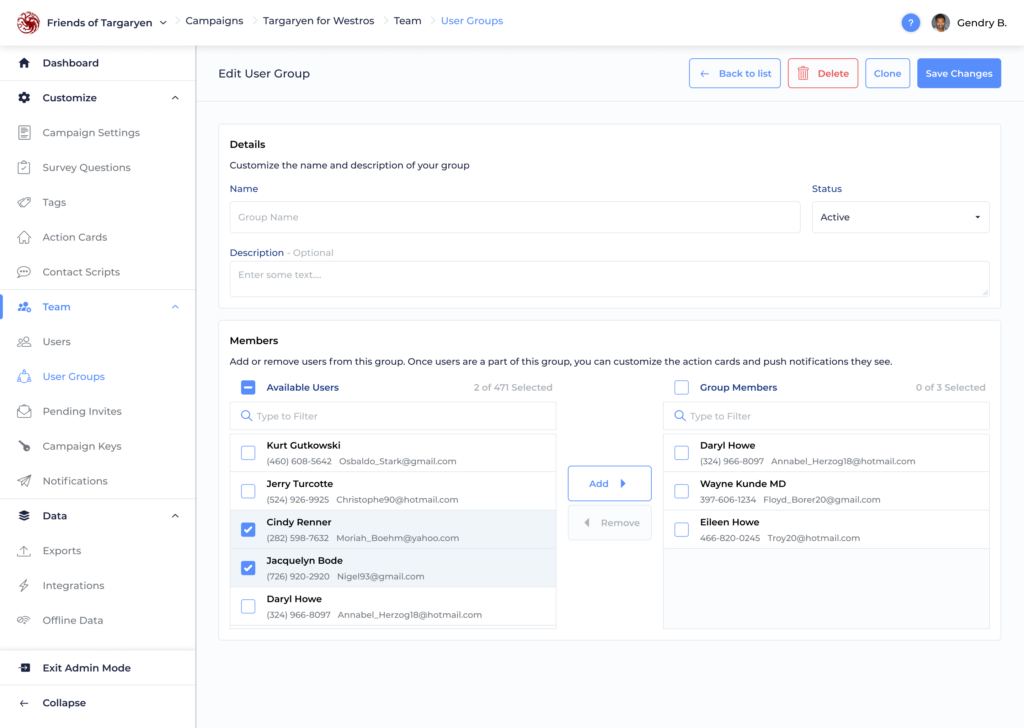User Groups
User Groups is a powerful feature of Reach which allows you to divide your users into various groups and then target other Reach features based on those groups. Users can be in as many groups as you want and groups can have as many users as you want.
Note that this feature is not available for Reach Basics campaigns. Reach Complete campaigns can have up to 10 user groups. Reach Movement campaigns can have unlimited user groups. For more information on our various subscription plans, see our Pricing page.

User Group Admin Basics
Each group gets a name, image, and description.
Privacy
User groups can be either Private or Public. Public groups will be visible to all of your users in the User Group Directory so they can browse, join and leave them. Private groups will never show in the User Group Directory and their names, images, and descriptions will only be visible to members of the groups and only if the groups have chat channels associated with them. Users of private groups will need to contact an admin if they would like be removed from the group.
Status
Groups can also be set to Active or Inactive status. Inactive groups will not appear elsewhere in Admin or in the app.
Membership
You can add and remove members from your group simply by selecting from all the users not currently in your group (on the left) and clicking the “Add” button to move them into your group (on the right). You can remove users from the group by doing the opposite. Don’t forget to click Save.
User Group Examples
You can get super creative with your user groups but here are some ideas to get you started:
- Users who speak specific languages
- Users who are organizing in specific neighborhoods
- Users who are working on specific organizing goals
- Users who share common interests
- Users who joined at specific events
What can your users groups do?
Chat Channels
Each user groups can have its own private channel in your campaign’s Reach Chat. Make sure the “Chat Channel” toggle is turned on when making a group or go edit an old group to turn it on. Then, users in that group will automatically see the chat channel on their chat screen.
Targeting Action Cards
Any new action card you make can be targeted to specific user groups, user roles, or individual users. For more on this, see the Action Cards Admin article.
Targeting Contact Scripts
Any contact script can be set to be visible only to members of certain groups.
Targeting Push Notifications
Any new push notification you send can be targeted to specific user groups, user roles, or individual users. For more on this, see the Push Notifications Admin article.
Targeting Question Sets
It is possible to set up question sets so certain sets are only visible to users within (or not in) a certain group. This can allow very powerful flows like private questions only visible to staff members in your organization, neighborhood-specific questions only visible to users in those neighborhoods, or questions sets in various languages only visible to users who speak those languages.
You can configure this from the bottom of the User Groups admin screen where you can select which question sets should be visible to or hidden from a given user group. Keep in mind that any set that is configured to be shown to at least one group will be visible only to members of those groups and hidden to any users not in those groups.
Linking Campaign Keys to User Groups
When creating or editing a Campaign Key from the Campaign Keys screen, you can specify one or several User Groups to be linked to that Campaign Key. This means that any time a user joins your campaign using that Key, they will be automatically added to those linked User Groups!
User Groups from the Users Admin Screen
It is possible to add and remove individual users from groups from the Users Admin Screen.
User Groups via the Reach API
User Groups can also be created and edited and managed by Reach Movement campaigns via the Reach API (docs at https://api.reach.vote). This is a great solution for campaigns which want to automate group creation and management. For example, you could write some code to have users automatically assigned to a group based on the zip code they provide when signing up.


